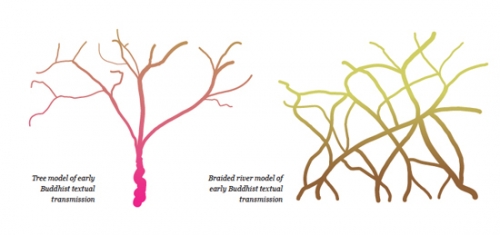In our Summer issue, we published a piece by Linda Heuman entitled, Whose Buddhism is Truest? about recently unearthed Gandharan scrolls. These scrolls, which had been buried in a desert and lost for some two-thousand years, once discovered and analyzed called into question many long held ideas about how Buddhism developed. It is a fascinating piece.
Recently, a friend of mine remarked that she felt that one image in the piece was itself an important teaching, for it “perfectly exemplifies the new prevailing view Buddhist history.” She went on to say, “they say a picture is worth a thousand words, but this one is worth a hundred thousand at least!”
It is this image of two diagrams:

The first is the “tree model of early Buddhist textual transmission.” This model explains Buddhist history as being like a tree, starting with historical Buddha and then branching out as Buddhism spread and took different forms. Makes sense doesn’t it? The Buddha started it all, his enlightenment was the seed, his life of teaching was the base of the trunk, and everything since is the growth, which 2,600 years later is now the many-branched Buddhist tree we know today. Yet as we learn from Linda’s piece, it was not that simple. It turns out that early Buddhist sanghas influenced and affected each other much more than was previously known, and therefore a better model is the “braided river,” which more accurately depicts the complex interweaving of Buddhist development.
To learn more about this revelation and what it may imply for Buddhists everywhere, I recommend reading the article.